
A pogrom is a violent riot incited with the aim of massacring or expelling an ethnic or religious group, particularly Jews. The term entered the English language from Russian to describe 19th- and 20th-century attacks on Jews in the Russian Empire. Similar attacks against Jews which also occurred at other times and places became known retrospectively as pogroms. Sometimes the word is used to describe publicly sanctioned purgative attacks against non-Jewish groups. The characteristics of a pogrom vary widely, depending on the specific incident, at times leading to, or culminating in, massacres.

Pinsk is a city in Brest Region, Belarus. It serves as the administrative center of Pinsk District, though it is administratively separated from the district. It is located in the historical region of Polesia, at the confluence of the Pina River and the Pripyat River. The region was known as the Pinsk Marshes and is southwest of Minsk. As of 2023, it has a population of 124,613.
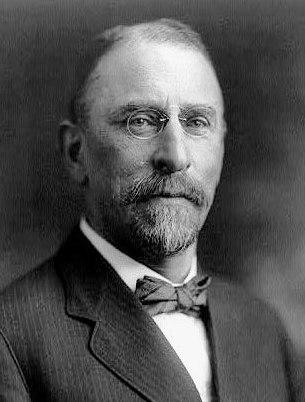
Henry Morgenthau was a German-born American lawyer and businessman, best known for his role as the ambassador to the Ottoman Empire during World War I. Morgenthau was one of the most prominent Americans who spoke about the Greek genocide and the Armenian genocide of which he stated, "I am firmly convinced that this is the greatest crime of the ages".
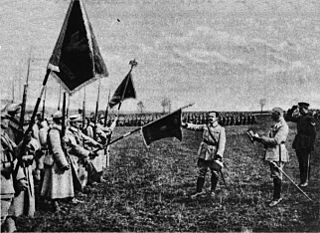
The Blue Army, or Haller's Army, was a Polish military contingent created in France during the latter stages of World War I. The name came from the French-issued blue military uniforms worn by the soldiers. The symbolic term used to describe the troops was subsequently adopted by General Józef Haller von Hallenburg himself to represent all newly organized Polish Legions fighting in western Europe.
Following the establishment of the Second Polish Republic after World War I and during the interwar period, the number of Jews in the country grew rapidly. According to the Polish national census of 1921, there were 2,845,364 Jews living in the Second Polish Republic; by late 1938 that number had grown by over 16 percent, to approximately 3,310,000, mainly through migration from Ukraine and the Soviet Russia. The average rate of permanent settlement was about 30,000 per annum. At the same time, every year around 100,000 Jews were passing through Poland in unofficial emigration overseas. Between the end of the Polish–Soviet War of 1919 and late 1938, the Jewish population of the Republic grew by nearly half a million, or over 464,000 persons. Jews preferred to live in the relatively-tolerant Poland rather than in the Soviet Union and continued to integrate, marry into Polish Gentile families, to bring them into their community through marriage, feel Polish and form an important part of Polish society. Between 1933 and 1938, around 25,000 German Jews fled Nazi Germany to sanctuary in Poland.

During World War II, the German Wehrmacht committed systematic war crimes, including massacres, mass rape, looting, the exploitation of forced labour, the murder of three million Soviet prisoners of war, and participated in the extermination of Jews. While the Nazi Party's own SS forces was the organization most responsible for the genocidal killing of the Holocaust, the regular armed forces of the Wehrmacht committed many war crimes of their own, particularly on the Eastern Front.
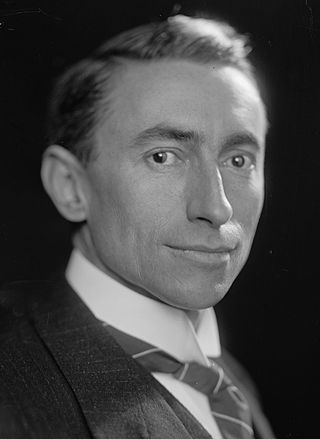
Hugh Simons Gibson was an American diplomat. He was actively involved in disarmament talks from 1925 to 1932. Throughout his career, he remained a leading proponent in the drive to establish a professional Foreign Service based on merit rather than personal wealth or political influence.

Antoni Listowski was a Polish military officer. After being a mayor general of the Imperial Russian Army, he became general in the Polish Armed Forces and took part in the Polish-Soviet War.

Controversies of the Polish–Soviet War, fought in 1919–20, concerning the behaviour of the military forces and crimes they committed. Each side charged the other with violations of international law in an effort to sway public opinion in the West, which was felt to be important for both sides.

Operation Mińsk was a military offensive of the Polish Army during the Polish–Soviet War. It resulted in the capture of Minsk from the Red Army around 8 August 1919. The victory allowed the Polish troops to advance further into Russian-controlled Lithuania and Belarus and thus to present the Bolsheviks with a military fait accompli. The main Polish attack was toward Maladzyechna, Minsk, and Polotsk along the railroad lines. On 6 August, the Polish Army took over Slutsk and Minsk was taken two days later. The Polish units fought under command of General Stanisław Szeptycki. Polish control over the railway lines prevented the Russians from bringing in reinforcements. By the end of August, the Polish forces had taken Barysaw and Babruysk.

The Vilna offensive was a campaign of the Polish–Soviet War of 1919–1921. The Polish army launched an offensive on April 16, 1919, to take Vilnius from the Red Army. After three days of street fighting from April 19–21, the city was captured by Polish forces, causing the Red Army to retreat. During the offensive, the Poles also succeeded in securing the nearby cities of Lida, Pinsk, Navahrudak, and Baranovichi.
The Morgenthau report, officially the Report of the Mission of the United States to Poland, was a report compiled by Henry Morgenthau, Sr., as member of the "Mission of the United States to Poland" which was appointed by the American Commission to Negotiate Peace formed by President Woodrow Wilson in the aftermath of World War I. The purpose of the mission was to investigate "alleged Polish pogroms" and the "treatment of the Jewish people" in Poland. The mission consisted of three American members: former US ambassador Henry Morgenthau, Brigadier General Edgar Jadwin of Engineer Corps, and professor of law Homer H. Johnson from Cleveland; and from the British side Sir Stuart M. Samuel. They were selected to investigate accounts of mistreatment of Jews in the newly-reborn Second Polish Republic. The report by Morgenthau was published on October 3, 1919.

Aleksander Narbutt-Łuczyński was a Polish lawyer and military officer, a brigadier general of the Polish Army and a veteran of both the Polish-Bolshevik War and World War II. During the German-Soviet invasion of Poland in 1939 he commanded the rear troops of the Kraków Army.

The Ciepielów massacre that took place on 8 September 1939 was one of the largest and best documented war crimes of the Wehrmacht during its invasion of Poland. On that day, the forest near Ciepielów was the site of a mass murder of Polish prisoners of war from the Polish Upper Silesian 74th Infantry Regiment. The massacre was carried out by soldiers from the German Army's 15th Motorized Infantry Regiment, 29th Motorized Infantry Division, under the command of Colonel Walter Wessel.
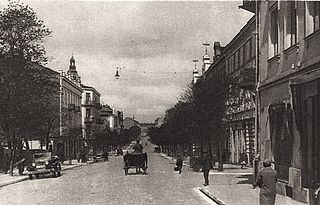
The Kielce pogrom of 1918 refers to the events that occurred on 11 November 1918, in the Polish city of Kielce located in current Świętokrzyskie Voivodeship. According to 1919 Report by Henry Morgenthau, Sr. who led the Mission of The United States to Poland; during Poland's fight for independence towards the end of the First World War, shortly after the Austro-Hungarian troops were evacuated from Kielce by their military command, the city authorities allowed local Jewish community to hold a rally at the Polish Theatre. The participants rallied behind the Jewish demand for political and cultural autonomy. According to one U.S. source, during the rally, anti-Polish speeches were also being delivered. A respected lawyer, Mr. Frajzyngier, who attempted to deliver a public address in Polish was booed. The angry audience shouted: "No Polish language here!" According to Stanisław Białek from the Jan Karski Society, the voices of protest sparked a rumour about the anti-Polish character of the meeting. As the meeting went on, a crowd of Polish onlookers gathered outside the theatre.

The Lwów pogrom was a pogrom perpetrated by Polish soldiers and civilians against the Jewish population of the city of Lwów. It happened on 21–23 November 1918, during the Polish–Ukrainian War that followed World War I.
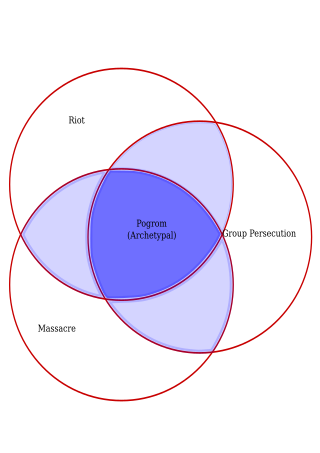
This article provides a list of definitions of the term pogrom. The term originated as a loanword from the Russian verb громи́ть, meaning "to destroy, to wreak havoc, to demolish violently". The events in Odessa during Holy Week in 1871 were the first to be widely called a "pogrom" in Russian, and the events of 1881–82 introduced the term into common usage throughout the world.
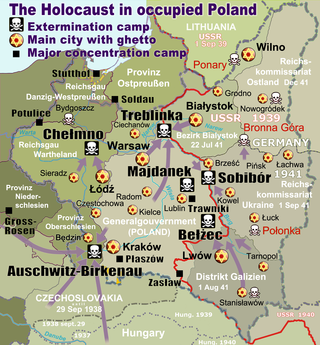
The Pińsk Ghetto was a Nazi ghetto created by Nazi Germany for the confinement of Jews living in the city of Pińsk, Western Belarus. Pińsk, located in eastern Poland, was occupied by the Red Army in 1939 and incorporated into the Byelorussian SSR. The city was captured by the Wehrmacht in Operation Barbarossa in July 1941; it was incorporated into the German Reichskommissariat Ukraine in autumn of 1941.

Bronna Góra is the name of a secluded area in present-day Belarus where mass killings of Polish Jews were carried out by Nazi Germany during World War II. The location was part of the eastern half of occupied Poland, which had been invaded by the Soviet Union in 1939 in agreement with Germany, and two years later captured by the Wehrmacht in Operation Barbarossa. It is estimated that from May 1942 until November of that year, during the most deadly phase of the Holocaust in Poland, some 50,000 Jews were murdered at Bronna Góra forest in death pits. The victims were transported there in Holocaust trains from Nazi ghettos, including from the Brześć Ghetto and the Pińsk Ghetto, and from the ghettos in the surrounding area, as well as from Reichskommissariat Ostland.
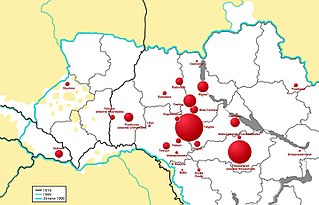
The pogroms during the Russian Civil War were a wave of mass murders of Jews, primarily in Ukraine, during the Russian Civil War. In the years 1918–1920, there were 1,500 pogroms in over 1,300 localities, in which up to 250,000 were murdered. All armed forces operating in Ukraine were involved in the killings, in particular the anti-Communist Ukrainian People's Army and Armed Forces of South Russia. It is estimated that more than a million people were affected by material losses, 50,000 to 300,000 children were orphaned, and half a million were driven out from or fled their homes. The Whitaker Report of the United Nations cited the massacre of 100,000 to 250,000 Jews in more than 2,000 pogroms which occurred during the White Terror in Russia as an act of genocide.



















